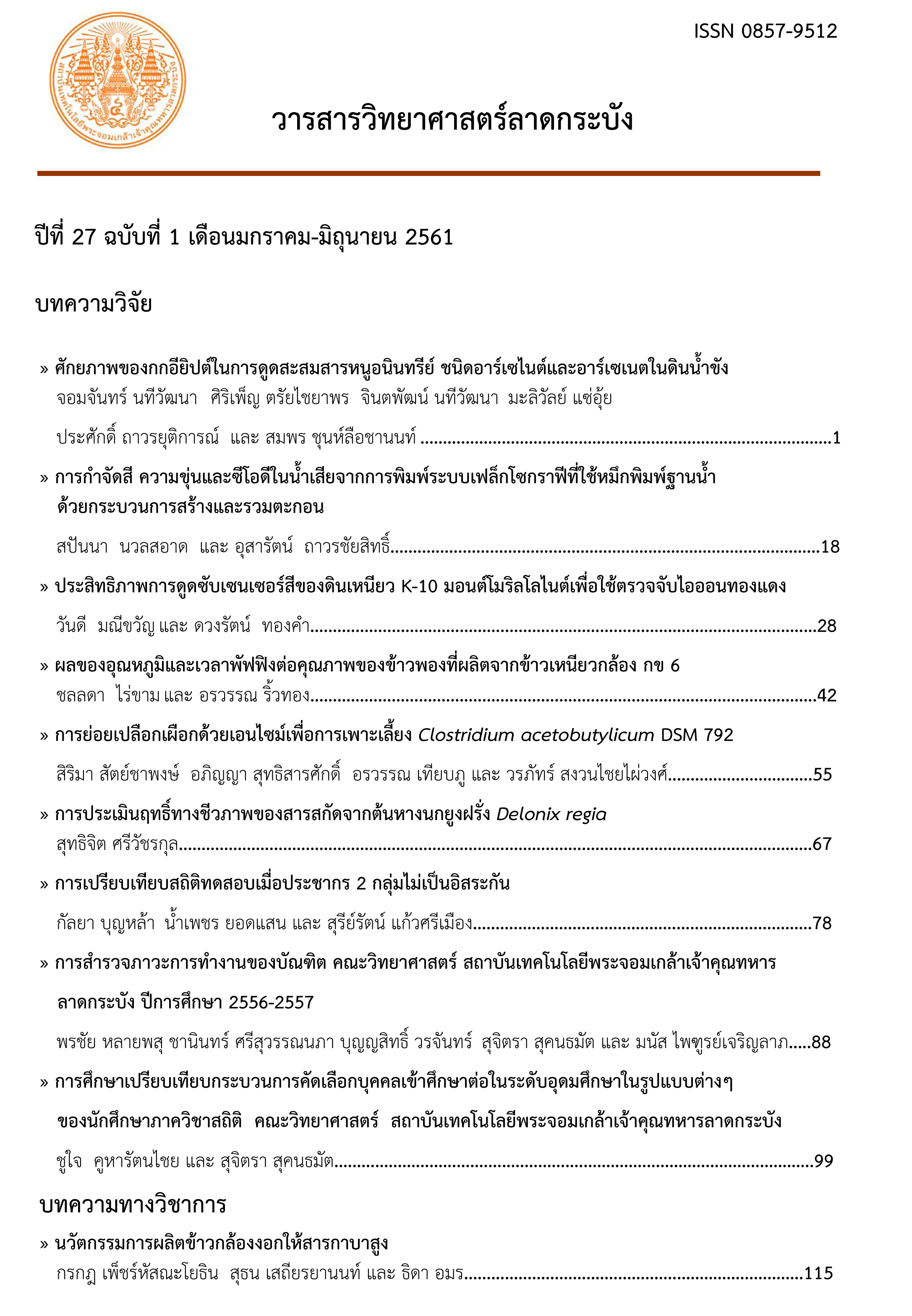การย่อยเปลือกเผือกด้วยเอนไซม์เพื่อการเพาะเลี้ยง Clostridium acetobutylicum DSM 792
Main Article Content
Abstract
งานวิจัยนี้มีวัตถุประสงค์ในการหาสภาวะที่เหมาะสมของการย่อยเปลือกเผือกเพื่อการเพาะเลี้ยง Clostridium acetobutylicum DSM 792 โดยนำเปลือกเผือกมาปรับสภาพด้วยกรดซัลฟูริก 1 โมลาร์ สารละลายโซเดียมไฮดรอกไซด์ 1 โมลาร์ หรือน้ำกลั่น ในสภาวะ 121 องศาเซลเซียส 15 ปอนด์ต่อตารางนิ้ว เป็นเวลา 20 นาที และนำมาย่อยด้วยเอนไซม์เซลลูเลส ในอัตราส่วน 1 มิลลิลิตรต่อตัวอย่าง 1 กรัม ซึ่งทำให้ได้ความเข้มข้นของน้ำตาลรีดิวซ์ 9.64 ±0.42 กรัมต่อลิตร เมื่อปรับสภาพด้วยสารละลายโซเดียมไฮดรอกไซด์ 1 โมลาร์ ซึ่งไม่เพียงพอต่อการผลิตสารผลิตภัณฑ์ของจุลินทรีย์ จึงนำเปลือกเผือกมาเจลลาติไนซ์และย่อยด้วยแอลฟาอะไมเลสและกลูโคอะไมเลสเพื่อย่อยแป้งสตาร์ช ปริมาณของน้ำตาลรีดิวซ์ที่ได้ คือ 8.54 ±0.27 กรัมต่อลิตร ดังนั้น จึงนำเอนไซม์ผสมประกอบด้วยเซลลูเลส แอลฟาอะไมเลส และกลูโคอะไมเลสมาใช้ และได้ปริมาณน้ำตาลรีดิวซ์ 30.12 ±0.81 กรัมต่อลิตร ในขั้นต่อไป ทำการหาสภาวะที่เหมาะสมต่อการย่อยของเอนไซม์ พบว่าเปลือกเผือก 15 กรัม ในสารละลาย 100 มิลลิลิตร และใช้เซลลูเลส 0.2 มิลลิลิตรต่อเปลือกเผือก 1 กรัม ให้ความเข้มข้นน้ำตาลรีดิวซ์ 31.79 ±1.14 กรัมต่อลิตร และนำมาเติมกลูโคสให้ได้ความเข้มข้นน้ำตาลรีดิวซ์ 50 กรัมต่อลิตร และใช้เป็นแหล่งคาร์บอนในการเพาะเลี้ยง Clostridium acetobutylicum DSM 792 พบความเข้มข้นของเอทานอล 11.01 ±0.55 กรัมต่อลิตร และบิวทานอล 5.33 ±0.27 กรัมต่อลิตร ที่ 24 ชั่วโมง
คำสำคัญ: เผือก Clostridium acetobutylicum การหมักแอซีโตน-บิวทานอล-เอทานอล การหมักไม่ใช้ออกซิเจน การย่อยด้วยเอนไซม์
This research was conducted to study the optimization of enzymatic hydrolysis of taro peel for the cultivation of Clostridium acetobutylicum DSM 792. Taro peel was pretreated with 1 M H2SO4, 1 M NaOH or distilled water at 121°C, 15 psi for 20 min and hydrolyzed by 1 mL cellulase per 1 g of sample. The basic pretreatment provided the highest concentrations of reducing sugar of 9.64 ±0.42 g/L from 1 M NaOH, which was inadequate for microbial production. Subsequently, to hydrolyze starch, taro peel was gelatinized and hydrolyzed by a-amylase and glucoamylase. The amount of reducing sugar obtained from amylase was 8.54 ±0.27 g/L. As a consequence, the mixed enzymes, cellulase, a-amylase and glucoamylase, were utilized and the reducing sugar content was 30.12 ±0.81 g/L. Afterwards, the optimization of enzymatic hydrolysis conditions was carried out. The optimal conditions were 15 g taro peel in 100-mL solution and 0.2 mL cellulase per 1 g of taro peel. The concentration of reducing sugars gained from this procedure was 31.79 ±1.14 g/L. Subsequently, this taro peel hydrolysate was utilized as a carbon source for the cultivation of Clostridium acetobutylicum DSM 792 with 50 g/L reducing sugar equivalence. It has been found that the highest concentrations of ethanol and butanol were 11.01 ±0.55 g/L and 5.33 ±0.27 g/L at 48 h, respectively.
Keywords: taro, Clostridium acetobutylicum, acetone-butanol-ethanol fermentation, anaerobic fermentation, enzymatic hydrolysis.

